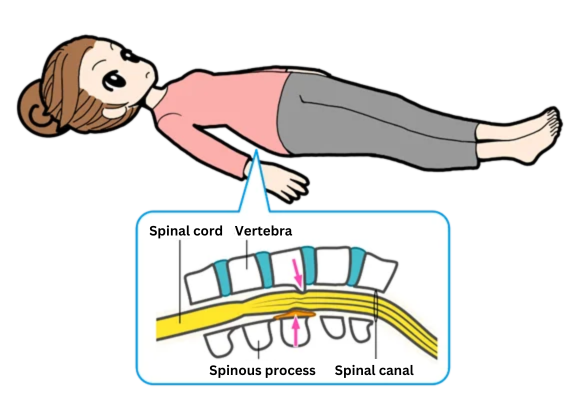Column 🛌Diagnosed with Spinal Stenosis? — What Are The Recommended Positions to Sleep Comfortably?🛌
June 09, 2025
The most prevalent spinal disorders are lumbar disc herniation, lumbar spinal canal stenosis, and spondylolisthesis.
In this article, we will explain how to sleep when you have spinal canal stenosis.
Symptoms and causes of spinal canal stenosis
The narrowing of the spinal canal, which is the pathway for the nerves, is called spinal canal stenosis. When the spinal canal is stenosed, the nerves that run through it are compressed.

Symptoms of spinal canal stenosis
Spinal canal stenosis can cause symptoms such as numbness and heaviness in both legs, pain and tingling in the buttocks, and abnormal sensations due to the compression of the nerves.
Another characteristic symptom of lumbar spinal stenosis is intermittent claudication. Intermittent claudication is a condition in which the patient feels pain or numbness in the legs when walking, but after a short rest, the patient experiences relief and can walk again, only to have the pain return after a short while.
Causes of spinal canal stenosis
The main causes of spinal canal stenosis are a thickening of the ligamentum flavum (yellow ligament), which is located behind the spine and stabilizes it; disc herniation, which begins with the aging of the intervertebral discs; and bone deformity (spondylolisthesis, intervertebral arthrosis, etc.).
Stenosis occurs when the disc protrudes toward the spinal canal or the intervertebral joints and the ligament become thickened due to aging or the strain of daily life.
How to sleep when you have spinal stenosis
If you sleep on your back
If you sleep on your back If you sleep on your back, lying on your back with your knees in an upright position will eliminate the hunched-over posture and reduce symptoms. Try to sleep with your knees bent with a cushion or rolled-up blanket tucked under your knees.

If you sleep on your side
on your side, It is easier to sleep on your side with your knees bent in the same way while holding a cushion.
The cushion you hold should be a little thinner and thicker than the width of your shoulders. If it is too small, it will not stabilize your position and you will end up in a prone position. If it is too large, it will take more strength just to hold the cushion, which will only increase the strain.

Bad ways to sleep when you have scoliosis
When you have scoliosis, it is not advisable to sleep on your back with your legs stretched out, because if you turn your back, the inside of the spinal canal will become even narrower and the nerves will be compressed, which will aggravate the symptoms.

You should also avoid sleeping on your stomach. The prone position makes it easier to arch the lower back, which puts more pressure on the spinal canal and leads to an aggravation of the symptoms.
Treatment of spinal canal stenosis once it occurs is also essential
Our clinic offers the Florence and Q-Florence methods for spinal canal stenosis.
The Florence and Q-Florence methods are minimally invasive, low-risk treatments for spinal stenosis.
Under partial anesthesia and sedation, a device is percutaneously inserted to widen the narrowed spinal canal.
Then a device is inserted to stabilize the vertebral body while preserving spinal rotation and flexion, widening the spinal canal and reducing the protrusion of the intervertebral disc and the thickening of the ligamentum flavum. The pain is relieved by widening the narrowed spinal canal.

The Q-Florence Method (article in Japanese)
If you have ever been diagnosed with spinal canal stenosis, please consider a consultation at our clinic.
Related Articles
Lumbar Spinal Canal Stenosis: Just What is Actually Happening to my Body?
The Different Symptoms of Spinal Canal Stenosis: If You Have Any of These, it’s a Red Flag!
Spinal Canal Stenosis, Progression and Symptoms: Of the Importance of Early Detection
What are the Various Complications Possible With Spinal Stenosis?
Diagnosis and Treatment of Spinal Stenosis: Why Early Detection is Critical
How to Prevent Spinal Canal Stenosis: Things to Implement in Your Daily Activity Routine



